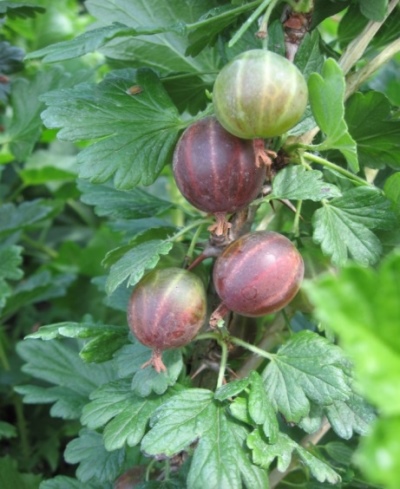
- Authors: K. N. Kopan, V. P. Kopan, Z. A. Shestopal (Lviv experimental gardening station (Ukraine))
- Growth type: vigorous
- Description of the bush: slightly spreading, with a compact crown of medium density
- Escapes: straight, brownish
- Thorniness: strong
- Thorns: powerful, dark-colored, one-two-part
- Sheet: five-lobed, deep green, slightly pubescent
- Spike location: located perpendicular to the shoot, sometimes obliquely down
- Berry size: medium and large
- Berry weight, g: 3,7-5,5
Neslukhovsky gooseberry is one of the most popular berry bushes in Ukraine. This variety is grown everywhere, appreciated for its early maturity and excellent taste. The heat-loving plant also feels good in Russia, especially in the middle lane, but difficulties may arise with the search for good seedlings.
Breeding history
The variety was obtained in 1970 by specialists from the Lviv Experimental Gardening Station and belongs to the American-European group. When crossing, the gooseberry Mlievsky red x Plum was used.
Description of the variety
Neslukhovsky is a variety that forms vigorous shoots up to 150-200 cm high. The crown is compact, neat, slightly spreading, not very dense. Shoots are strongly studded, straight, with a brownish skin. Leaves in the crown are five-lobed, slightly pubescent, brightly colored.
Characteristics of berries
Gooseberry Neslukhovsky gives medium-large and large berries weighing up to 3.7-5.5 g. The shape of each berry is round-oval, regular, the skin is of medium thickness, rather strong, slightly pubescent. The shells of the fruits are colored in all shades of dark red and purple. There is a light waxy coating on the surface of the berry.
Taste qualities
Gooseberries of this variety are especially appreciated for their pleasant, dessert taste. Its pulp is sweet and sour, tender and juicy. There is a fruity aroma. The tasting score is high, the variety gets an average of 4.8-5 points. Berries are especially good fresh, frozen and desserts.
Ripening and fruiting
The variety is early, harvesting begins at the end of June. He begins to bear fruit for 2 years.
Yield
From each bush in the season, you can collect 3-4 kg of berries. For this indicator, the variety is considered a high-yielding variety.
Growing regions
The variety is well adapted to planting throughout the territory of the Russian Federation. Most often grown in the Non-Black Earth Region, Moscow Region.
Landing
The variety is suitable for planting on fertile soils, grows well on loam and sandy loam, loose garden soil. Areas with a close occurrence of groundwater or swampy areas, ravines and lowlands are not suitable. The acidity should be neutral. The variety is very sensitive to the abundance of sunlight and needs to be planted in well-lit areas.
Pits for planting are prepared in advance, 3-4 weeks in advance, or from autumn, if the planting is spring. The more fertile the soil, the less preliminary preparation will be needed. Humus and other organic matter are laid in poor soils, flavored with superphosphate, wood ash. The holes themselves measuring 50 × 50 cm are dug at a distance of 2 m from each other.
When planting in autumn, the plants are transferred to a new place in the 2-3 decade of September. In the south until October. The seedling is set so that the root collar is about 100 mm below the edge of the fossa. Then everything is sprinkled with soil, compacted, abundantly watered with settled warm water. The next day, the soil will need to be mulched.

Growing and care
Gooseberry bushes of this variety need annual pruning. The first is carried out immediately after rooting of seedlings, with the removal of up to 1/3 of the shoots. Then each spring you will have to cut the broken, weak and diseased branches, burning this material. The crown, if it becomes too thick, also needs to be thinned out periodically.
For the rest, agricultural technology is not difficult. Neslukhovsky needs periodic watering, at least 1 time a week, In the heat it is moistened more often, be sure to weed, loosen and mulch the soil. Top dressing will only be needed for 2-3 years. You can choose a good complex or use plant materials as a source of nitrogen, wood ash and other natural fertilizers, growing a crop without pesticides.



Disease and pest resistance
According to the breeders, the Neslukhovsky gooseberry is resistant to septoria and is weakly affected by the "American" - a subspecies of powdery mildew. In general, immunity is quite high. Shoots can suffer from invasions of glass.

In order for the gooseberry to produce a good harvest, it is necessary to devote time to disease prevention.
Resistance to adverse climatic conditions
The bushes are winter-hardy, tolerate spring frosts well.

Review overview
Ukrainian and Russian gardeners speak well of this gooseberry variety. Many summer residents call Neslukhovsky the crown of their collection, praise it for its unsurpassed taste and beautiful, bright skin color. It ripens early, especially in warm climates, the berries retain their properties on the bush for a very long time, they are not baked in the heat, and are well stored after removal.
The main disadvantage of this variety, gardeners call thorns, powerful thorns that cling to the skin and clothing when harvesting. And also there are references to the cracking of berries during prolonged rainy periods. Such fruits rot very quickly. Ripening in the shade also slows down.



































































